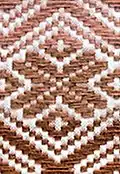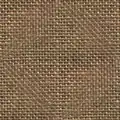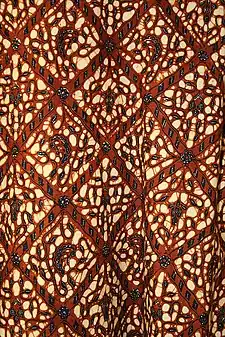Dorea (Doriyā, Doreas, Dooreas, Doriyah) was a type of striped or check patterned cloth made in the Indian subcontinent. The continued (warp side) striped Dorea was a simplest form of Dorea.[1][2]
Doriya was a kind of cloth, originally made of cotton, but later made of silk, or tussar or silk and cotton both. It has a flimsy texture when compared to Ilayecha. Doriya was also called "a striped cloth", with stripes running along with the warp of the cloth.[3][4][5]
"Are-doriya" was a type with diagonal stripes, while "Salaidar" was a cloth in which the stripes were across the width or in the weft.[6][7][8]
Mention
"Ain-i-Akbari" is a document from the Mughal empire. Doriya's name is mentioned there, along with contemporary cotton fabrics such as Khasa, Salu, Bafta, Tansukh, Dupatta, and Panchtoliya.[9][10]
Fabric
Originally it was made of cotton only, the cloth was later manufactured with silk and other type of materials as well.[1]
the warp consists of three parts of cotton and two parts of Tasar or different colors. The woof is all cotton of one color, so that the cloth is striped lengthways, and is dyed entirely by the weavers in the thread
Exports
Bengal exported a variety of fabrics ranging in fineness from ''Dorea to Sologazi, Chela, Sanu, Rumal, Fota, Chintz, Guinea cloth, Garra, and Sailcloth.''[12]
See also
References
- 1 2 Montgomery, Florence M. (1984). Textiles in America 1650-1870 : a dictionary based on original documents, prints and paintings, commercial records, American merchants' papers, shopkeepers' advertisements, and pattern books with original swatches of cloth. Internet Archive. New York ; London : Norton. pp. 222, 223. ISBN 978-0-393-01703-8.
- ↑ Thomas, p j (1926). Mercantilism And The East India Trade. p. 30.
- ↑ Yule, Sir Henry; Burnell, Arthur Coke (1903). Hobson-Jobson: A Glossary of Anglo-Indian Words and Phrases, and of Kindred Terms, Etymological, Historical, Geographical and Discursive. Murray. p. 707.
- ↑ A Monograph on Silk Fabrics Produced in the Northwestern Provinces and Oudh. Printed at the N.-W. Provinces and Oudh Government Press. 1900. pp. 94, 95.
- ↑ Hariharan, Shantha (2002). Cotton Textiles and Corporate Buyers in Cottonopolis: A Study of Purchases and Prices in Gujarat, 1600-1800. Manak Publications. p. 253. ISBN 978-81-7827-039-5.
- ↑ Saraswati, Sarasi Kumar (1961). Indian Textiles. Publications Division, Ministry of Information and Broadcasting, Government Of India.
Striped fabrics are known as doriya or salaidar , the name depending on whether the stripes are longitudinal or across the width of the material . Are - doriya is the name for fabrics with diagonal stripes
- ↑ Watt George (1903). Indian Art At Delhi, 1903. p. 294.
- ↑ Mehta, Rustam Jehangir (1960). The Handicrafts and Industrial Arts of India: A Pictorial and Descriptive Survey of Indian Craftsmanship as Seen in Masterpieces ... Taraporevala's Treasure House of Books. p. 100.
- ↑ Congress, Indian History (1967). Proceedings. Indian History Congress. p. 243.
- ↑ Proceedings. Publication Bureau, Punjab University. 1987. p. 57.
- ↑ Establet, Colette; Pascual, Jean-Paul (2014-03-10), "Deuxième partie", Des tissus et des hommes : Damas vers 1700, Études arabes, médiévales et modernes, Beyrouth: Presses de l’Ifpo, pp. 193–236, ISBN 978-2-35159-474-2, retrieved 2021-07-09
- ↑ Gunderson, Warren M. (1975). Studies on Bengal: Papers Presented at the Seventh Annual Bengal Studies Conference, University of Minnesota, Minneapolis, Minnesota, May 28-30, 1971. Asian Studies Center, Michigan State University. p. 74.



.svg.png.webp)